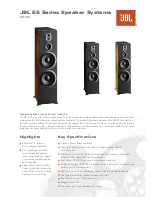
80
ent button. For example, in the steps
below, we will explain how to program
the digital recorder buttons to provide the
commands to operate a VCR. Of course,
you may program the remote to have any
of the devices take on the code set of any
other device, as your system requires.
And, with the remote’s “Edit” function,
you can even change the way the name
of the device appears on the remote’s
LCD display so that you see exactly which
commands are being sent.
NOTE:
You may not change the device
types for the DVD/MAIN device
(CVR700’s internal DVD/CD changer), the
FM/AM (TUNER) device, the SCREEN
device (controls CVPD50 functions) or the
SYSTEM device (controls CVR700’s
receiver functions).
To program the buttons normally assigned
to one device for the commands of
another, follow these steps:
1. Press and hold the
Remote Menu
Button
b
for about 3 seconds
while the message shown in Figure
54 appears in the remote’s
LCD
Information Display
2
. Release
the button when the red light under
the
Set Button
s
appears.
2. The remote’s
MAIN MENU
message
(Figure 55), will appear in the LCD
display and the
Set Button
s
will
remain illuminated in red. Press the
⁄
Navigation Button
q
until
CHANGE DEVICE
appears on the
bottom line of the LCD screen, as
shown in Figure 75. Press the
Set
Button
s
to begin the process of
reassigning the commands used for a
particular device.
Figure 75
3. Next, you will select the
Input
Selector
d
for the device that you
wish to change. When the display
shown in Figure 76 appears, press the
⁄
/
¤
Navigation Button
q
to
scroll through the list to find the
device you wish to use for another
function. In this case, we will select
“TIVO,” and show how to change it to
take on the codes for operating a
VCR. When that device’s name
appears, press the
Set Button
s
.
Figure 76
4. Once the “old” device type has been
selected, you need to tell the remote
which set of remote codes to use as a
replacement for the device just selected.
When the instructions shown in
Figure 77 appear, press the
⁄
/
¤
Navigation Button
q
to scroll
through the list of device categories
to find the name of the device that
you wish to use. The old device name
will remain on the left side of the
LCD screen, while the replacement
device list will scroll to its right. For
example, press the
⁄
Navigation
Button
q
until the display screen
reads
TIVO
<
-VCR
to have the digi-
tal recorder Button transmit the com-
mands used to control a VCR. Press
the
Set Button
s
when the
desired device combination appears.
Figure 77
5. Once the new device is selected, the
remainder of the process will select
the codes for the specific brand to
be used, and for that reason they
are identical to the way a device is
programmed using manual entry.
Continue the process as outlined in
the next few steps, remembering that
if the codes for your specific device
are not found, you may select any
brand and then “learn” the proper
codes into the remote using the
process outlined on page 78. To begin
the process, start by selecting the
brand of device, as shown in Figure
57. Press the
⁄
/
¤
Navigation
Button
q
until the brand name of
the device you are programming into
the remote appears on the lower line
of the display and then press the
Set Button
s
.
6. The next step is important, as it
determines which codes will operate
the source device or display. Point
the remote at the device being pro-
grammed and, following the instruc-
tions shown on the remote’s
LCD
Information Display
2
, press
and release the
Numeric Keys
l
one at a time, starting with the
“1”
Button
l
. After you press the
“1”
Button
l
, the remote’s LCD screen
will briefly go blank as the code is
being transmitted, but you will see
the “transmit” icon in the upper right
corner of the display to serve as con-
firmation that the remote is sending
out commands.
7. After you press and release the num-
ber key, watch the device being pro-
grammed to see whether it turns off.
As shown in the instructions that will
appear on the next menu screen
(Figure 61), press the
Set Button
s
, and then skip to Step 9. If the
unit does
not
turn off, proceed to the
next step.
8. If the device being programmed into
the remote does
not
turn off after you
have pressed the
“1” Button
l
,
continue Steps 6 and 7 by pressing
the available numeric keys shown
until the device turns off. If the device
still does not turn off after all choices
have been tried, the code for this
specific device is not in the remote
library under that brand name. If that
is the case, we suggest that you
press the
Set Button
s
to accept
the codes from another brand so that
the programming is completed, but
remember that you will then have to
program the remote manually by fol-
lowing the Learning Commands
instructions on page 78.
9. When the device being programmed
does
turn off after a numeric key has
been pressed, you must press the
Set
Button
s
within five seconds to
enter the setting into the remote’s
memory. After you press the Set but-
ton, the top line of the LCD display
will read
SAVING...
and then the
word
SAVED
will flash four times in
the center of the bottom line.
10. When the codes are saved the remote
will return to normal operation, and
whenever you press the
Input
Selector Button
3
that was just
programmed, the display will show
the original device type code at the
far left side of the display, with the
name of the new code set type in
brackets. For example, the display
will read
TIVO
<
-VCR
in our exam-
ple of replacing the TiVo codes with
those for a VCR.
Macro Programming
Macros enable you to easily repeat fre-
quently used combinations of multiple
remote control commands with the touch
of a single button. Once a macro is pro-
grammed, you may send up to 20 com-
mands with one press of the Power On or
Macro buttons. This will greatly simplify
the process of turning on your system,
changing devices or other common tasks.
Thanks to the remote’s two-line display, it
N E W D E V I C E T Y P E
T I V O
<
- V C R
O L D D E V I C E T Y P E
T V
M A I N M E N U
C H A N G E D E V I C E
CVR700 OM 12/17/04 4:24 PM Page 80
















































